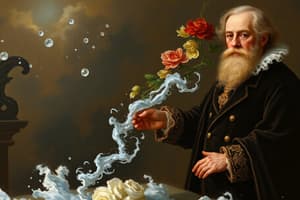Podcast
Questions and Answers
A gas is held within a container of fixed quantity. According to Boyle's Law, what change will always result in an increase in pressure?
A gas is held within a container of fixed quantity. According to Boyle's Law, what change will always result in an increase in pressure?
- Decreasing the volume of the container while maintaining a constant temperature. (correct)
- Increasing the volume of the container while keeping the temperature constant.
- Decreasing the temperature of the gas while increasing the volume of the container.
- Increasing the temperature of the gas while maintaining a constant volume.
A balloon contains $5L$ of air at $100 kPa$. If the pressure is increased to $200 kPa$ while keeping the temperature constant, what is the new volume of the balloon, assuming ideal behavior?
A balloon contains $5L$ of air at $100 kPa$. If the pressure is increased to $200 kPa$ while keeping the temperature constant, what is the new volume of the balloon, assuming ideal behavior?
- $10L$
- $20L$
- $5L$
- $2.5L$ (correct)
Which of the following provides the most accurate explanation of why gas pressure increases when the volume of a container is reduced at constant temperature?
Which of the following provides the most accurate explanation of why gas pressure increases when the volume of a container is reduced at constant temperature?
- The gas molecules collide more frequently with the walls of the container. (correct)
- The gas molecules collide less frequently with each other.
- The force exerted by individual gas molecules decreases.
- The average speed of the gas molecules decreases.
A container of gas has a pressure of $3 atm$ and a volume of $10 L$. If the volume is isothermally changed to $5 L$, what would be the new pressure?
A container of gas has a pressure of $3 atm$ and a volume of $10 L$. If the volume is isothermally changed to $5 L$, what would be the new pressure?
A syringe is used to draw liquid. Which statement most accurately describes the pressure changes inside the syringe when the plunger is pulled out, assuming constant temperature?
A syringe is used to draw liquid. Which statement most accurately describes the pressure changes inside the syringe when the plunger is pulled out, assuming constant temperature?
Divers need to be aware of Boyle's Law. If a diver takes a $3L$ air bubble at $30m$ where the pressure is $400 kPa$, what volume would this air bubble occupy if it rose to the surface where the pressure is $100 kPa$, assuming the temperature remains constant?
Divers need to be aware of Boyle's Law. If a diver takes a $3L$ air bubble at $30m$ where the pressure is $400 kPa$, what volume would this air bubble occupy if it rose to the surface where the pressure is $100 kPa$, assuming the temperature remains constant?
A gas occupies $10 m^3$ at standard pressure. Which of the following statements best describes the volume change if the pressure is tripled while the temperature is kept constant?
A gas occupies $10 m^3$ at standard pressure. Which of the following statements best describes the volume change if the pressure is tripled while the temperature is kept constant?
When the volume of a gas is halved and the temperature is kept constant, which of the following statements is most accurate regarding the gas's density?
When the volume of a gas is halved and the temperature is kept constant, which of the following statements is most accurate regarding the gas's density?
A balloon is filled with air at 27°C and has a volume of 10L. If the temperature is increased to 227°C, what will be the new volume of the balloon, assuming the pressure remains constant?
A balloon is filled with air at 27°C and has a volume of 10L. If the temperature is increased to 227°C, what will be the new volume of the balloon, assuming the pressure remains constant?
Which of the following statements accurately reflect Charles's Law?
Which of the following statements accurately reflect Charles's Law?
A rigid container holds a gas at 300 K and 150 kPa. If the temperature is increased to 450 K, what will be the new pressure inside the container?
A rigid container holds a gas at 300 K and 150 kPa. If the temperature is increased to 450 K, what will be the new pressure inside the container?
According to Avogadro's Law, what happens to the volume of a gas if the number of moles of the gas is doubled, while temperature and pressure are kept constant?
According to Avogadro's Law, what happens to the volume of a gas if the number of moles of the gas is doubled, while temperature and pressure are kept constant?
Which of the following best describes an 'ideal gas' in the context of gas laws?
Which of the following best describes an 'ideal gas' in the context of gas laws?
Which of the following is a real-world application that demonstrates the principles of Charles's Law?
Which of the following is a real-world application that demonstrates the principles of Charles's Law?
A container of gas at a constant volume has a pressure of 2 atm at 200 K. If the pressure increases to 4 atm, what is the new temperature?
A container of gas at a constant volume has a pressure of 2 atm at 200 K. If the pressure increases to 4 atm, what is the new temperature?
Which of the following is an example of Avogadro's Law in action?
Which of the following is an example of Avogadro's Law in action?
Flashcards
Absolute Temperature
Absolute Temperature
Temperature measured using the Kelvin scale. To convert Celsius to Kelvin, add 273.
Charles’s Law
Charles’s Law
For a fixed mass of gas at constant pressure, volume is directly proportional to absolute temperature.
Ideal Gas
Ideal Gas
A gas that obeys gas laws at all temperatures and pressures.
Pressure Law (Gay-Lussac's Law)
Pressure Law (Gay-Lussac's Law)
Signup and view all the flashcards
Avogadro's Law
Avogadro's Law
Signup and view all the flashcards
V ∝ T
V ∝ T
Signup and view all the flashcards
P ∝ T
P ∝ T
Signup and view all the flashcards
Avogadro’s law
Avogadro’s law
Signup and view all the flashcards
Pressure Definition
Pressure Definition
Signup and view all the flashcards
Pressure Unit
Pressure Unit
Signup and view all the flashcards
Gas Pressure Origin
Gas Pressure Origin
Signup and view all the flashcards
Gas Pressure Factors
Gas Pressure Factors
Signup and view all the flashcards
Boyle's Law
Boyle's Law
Signup and view all the flashcards
Boyle's Law Equation
Boyle's Law Equation
Signup and view all the flashcards
Syringe Application
Syringe Application
Signup and view all the flashcards
Breathing and Boyle's Law
Breathing and Boyle's Law
Signup and view all the flashcards
Study Notes
- The study notes cover the particulate nature of matter, specifically focusing on gas laws.
Boyle's Law
- Objectives include analyzing the relationship between pressure and volume and applying concepts to solve problems related to the law.
- Application examples are syringes, breathing, and diving.
- Pressure: Force per unit area.
- P = F/A, where A is the area on which the force acts.
- The unit of pressure is N/m² or pascal (Pa).
- The gas pressure comes from the force of the gas molecules colliding with the walls of the container.
- The pressure of a gas depends on the number of gas particles, container volume, and absolute temperature.
- Decreasing the volume of a container causes gas molecules to strike the walls more often, increasing pressure.
- For a given mass of gas, pressure (P) is inversely proportional to its volume when temperature is constant.
- P ∝ 1/V
- PV = constant
- P₁V₁ = P₂V₂
Charles's Law
- Objectives: analyze the relationship between volume and temperature, and applying concepts to solve problems related to Charles's law.
- Real-life applications of Charles's Law include hot air balloons, baking/cooking, and combustion processes in car engines.
- Absolute temperature is measured using the kelvin scale.
- Temperature in kelvin = Temperature in °C + 273 (Example: 25 °C = 25 + 273 = 298 K)
- The volume (V) of a fixed mass of a gas at constant pressure is directly proportional to absolute temperature (T).
- V ∝ T
- V/T = constant
- V₁/T₁ = V₂/T₂
- An ideal gas obeys gas laws at all temperatures and pressures.
Pressure Law, Avogadro's Law, and the Ideal Gas Equation
- Objectives: analyzing the relationship between pressure and temperature; applying concepts to solve problems related to the pressure law; applying concepts of Avogadro's law and the ideal gas equation.
- Real-life applications are pressure cookers, gas storage tanks, and industrial gas production.
- The pressure of a fixed quantity of gas at constant volume is directly proportional to the absolute temperature.
- P ∝ T
- P₁/T₁ = P₂/T₂
Avogadro's Law
- The quantity of gas (in mol) at constant temperature and pressure is directly proportional to the volume of the gas.
- n ∝ V
- V₁/n₁ = V₂/n₂
Ideal Gas Equation
- PV = nRT
- P₁V₁/n₁T₁ = P₂V₂/n₂T₂
- P is pressure (Pa)
- V is volume (m³)
- n is the amount (mol)
- R is the gas constant (8.31 J K⁻¹ mol⁻¹)
- T is temperature (K)
Studying That Suits You
Use AI to generate personalized quizzes and flashcards to suit your learning preferences.




